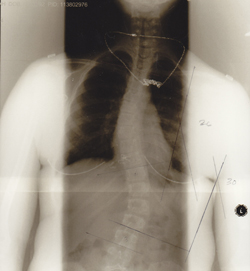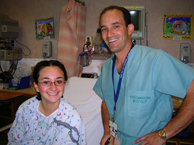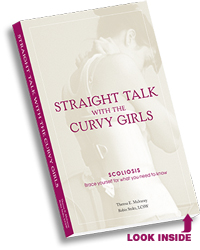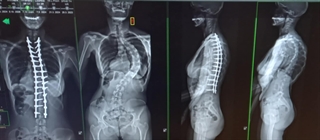Leah's Story: Coming Full Circle
Excerpts from the book Straight Talk with the Curvy Girls
 Everything is spinning. Two thousand kids are shouting but I can't hear them. A tiara is placed on my head and a bouquet of red roses in my hands. "Breathe, Leah, Breathe!" says Nick Cannon, the Chairman of TeenNick, as he wraps his arm around my shoulders and puts a microphone in front of my face. I probably wouldn't believe this memory was real if there hadn't been a film crew to record every moment.
Everything is spinning. Two thousand kids are shouting but I can't hear them. A tiara is placed on my head and a bouquet of red roses in my hands. "Breathe, Leah, Breathe!" says Nick Cannon, the Chairman of TeenNick, as he wraps his arm around my shoulders and puts a microphone in front of my face. I probably wouldn't believe this memory was real if there hadn't been a film crew to record every moment.
Then he announced, "I'm here to give back to someone who's been giving back her entire life." Tears start streaming down my face; I can't believe he's talking about me!
 I vaguely recall being told I had scoliosis, a condition that left me with two titanium rods and 22 screws in my back. However, it was that fateful doctor's visit when I was eleven and a half years old that changed my life. I was finishing my first year of middle school when the curve in my spine began to consume my world. My body had betrayed me; I didn't feel normal. But who would be happy having to wear a back brace for 23 hours a day, seven days a week for two and a half years?
I vaguely recall being told I had scoliosis, a condition that left me with two titanium rods and 22 screws in my back. However, it was that fateful doctor's visit when I was eleven and a half years old that changed my life. I was finishing my first year of middle school when the curve in my spine began to consume my world. My body had betrayed me; I didn't feel normal. But who would be happy having to wear a back brace for 23 hours a day, seven days a week for two and a half years?
I believe that I diagnosed myself. Only three months after our school screening, I was scratching around the middle of my back when I felt my spine curved. My pediatrician said that if it was anything, it was a very minor curve of possibly five degrees. My mom pointed out the distinctive "S" my spinal column formed. The following week when we went to see the orthopedist, the x-ray showed a different picture.
My main curves measured 37 degrees with a compensatory curve of 24. How did they miss that? And then the awful happened - that plastic thing staring at me from my orthotist's hands. How was it possible for anyone to wear that? I felt like the world wanted to keep me down. Sixth grade was probably the worst year. First, my best friend dropped me and now I was diagnosed with scoliosis. Facing scoliosis without a best friend left me feeling extremely lonely.
Trying to find clothes that would fit over the dreaded brace was an exercise in futility. I was in the dressing room surrounded by clothes two sizes too big. Outfit after outfit, I couldn't look in the mirror one more time to see my awkward shape. It felt hopeless. This was no longer my body but a body the brace formed. I continued crying as I looked at my reflection, disgusted.
 Then there was changing for gym class and fearing exposure. One of the challenges of wearing a brace to school was how I would get it off and on without anybody noticing. I ended up shamefully changing in the nurse's office supply closet or bathroom and consequently arriving late for gym class. I didn't want to call more attention to myself by walking into class late. I wanted to hide my brace and keep my scoliosis a secret from my secluded middle school world. Wearing a brace changed me; I had always been outgoing, but now I began to keep to myself.
Then there was changing for gym class and fearing exposure. One of the challenges of wearing a brace to school was how I would get it off and on without anybody noticing. I ended up shamefully changing in the nurse's office supply closet or bathroom and consequently arriving late for gym class. I didn't want to call more attention to myself by walking into class late. I wanted to hide my brace and keep my scoliosis a secret from my secluded middle school world. Wearing a brace changed me; I had always been outgoing, but now I began to keep to myself.
I continued to wear my brace faithfully everyday for twenty-three hours. A year and a half into bracing, my primary curve had gone from 37 degrees to 47 degrees. Because it was a slow increase over a year's time, my orthopedist was not alarmed. If my curves remained relatively stable and my body didn't grow more, he felt satisfied that I would not need surgery.
It was suggested we seek an opinion from another physician. We went with our own digital x-rays but they wanted their own. We waited in the bowels of the hospital for the new x-rays to be taken. When the doctor looked at my new x-rays, he said that I no longer had to wear my brace. I thought, "These sure are special x-rays!" He explained that bracing after 40 degrees was shown not to be effective. Now don't get excited and throw away your brace because that is just a statistic. Many kids wear braces for curves that are more than 40 degrees.
 The next question we asked was if we chose to continue with bracing, was my current brace sufficient. For that, we went to the orthotist across the hall who took one look at my brace and announced that it was completely ineffective. Wearing only my underwear, a bra and a tank top, he proceeded to push and pull me into wet gauze, while he ran over my toes with a wheelie chair. My winces were met with more pulling and pushing. When he began to wrap my chest, I tearfully called out. Why was I being fitting for a new brace that was even more restrictive then the first, when the doctor said I didn't need to even wear a brace anymore?
The next question we asked was if we chose to continue with bracing, was my current brace sufficient. For that, we went to the orthotist across the hall who took one look at my brace and announced that it was completely ineffective. Wearing only my underwear, a bra and a tank top, he proceeded to push and pull me into wet gauze, while he ran over my toes with a wheelie chair. My winces were met with more pulling and pushing. When he began to wrap my chest, I tearfully called out. Why was I being fitting for a new brace that was even more restrictive then the first, when the doctor said I didn't need to even wear a brace anymore?
From then on we have never gone to a doctor's appointment without asking tons of questions and being sure that we were well informed of what they wanted to do before we found ourselves doing something we didn't plan on.
After wearing this new brace for a couple of days, my doctor informed us that it was made incorrectly; it was the exact opposite of what it should have been.
Breaking the Secret
 Secrets are burdens, and this one showed no matter how hard I tried to keep it hidden. So much of my mental energy was spent thinking of ways to hide my "secret"; it was exhausting. The crazy thing about adolescent idiopathic scoliosis (AIS) is that it usually happens during middle school; a time when you worry about fitting in. I felt embarrassed about having to wear a brace to school. I was afraid that someone would bump into me in the hall and feel my abs of plastic. If I dropped anything on the floor, I couldn't bend to pick it up and changing for gym posed a real challenge. AIS was my big secret. Because it's not readily obvious, we think we can hide it from the world and that is exactly what I tried to do. With the exception of my school nurse and gym teacher, I told no one outside of my family until an eighth grade biology science presentation.
Secrets are burdens, and this one showed no matter how hard I tried to keep it hidden. So much of my mental energy was spent thinking of ways to hide my "secret"; it was exhausting. The crazy thing about adolescent idiopathic scoliosis (AIS) is that it usually happens during middle school; a time when you worry about fitting in. I felt embarrassed about having to wear a brace to school. I was afraid that someone would bump into me in the hall and feel my abs of plastic. If I dropped anything on the floor, I couldn't bend to pick it up and changing for gym posed a real challenge. AIS was my big secret. Because it's not readily obvious, we think we can hide it from the world and that is exactly what I tried to do. With the exception of my school nurse and gym teacher, I told no one outside of my family until an eighth grade biology science presentation.
Topics were randomly picked out of a bowl and there was no topic swapping. At the end of class, I approached my teacher, raising my shirt slightly so she could peek at my plastic torso. Her encouragement to do my report on scoliosis was the turning point in my secret life of bracing.
On the day of the presentation, life size images of my inners were projected on the screen. I carried my brace in my hands. All eyes were on me as I explained what scoliosis looks like inside and out. It wasn't until I learned how to share my "secret" that I could return to my outgoing self. Now if someone asked why I couldn't bend to pick up their pencil, I could tell them. If a kid knocked into me in the hallway, I could respond with, "abs of steel."
I was in ninth grade the first time I started taking my brace off during school without my parents knowing. It was such a cute outfit, and the brace really spoiled the look. Plus, I was in high school now! I wanted to be cool, not… lumpy. So right before first period I went into the locker room, quickly whipped it off and stuck it where I'd put it during gym, but this time, it would be there for six hours. I remember this feeling of paranoia. What if within these couple of hours all the work I'd done for the past two years is reversed? The worst was the thought of someone discovering it in the locker room and either vandalizing it or giving it to one of the coaches and then my mom would find out. But no one looked at me any differently that day. Maybe I wanted a couple people to comment on how much better I looked without the brace, but when it came down to it, I guess I realized how much people really couldn't tell when I was wearing it. I only did that a couple more times, but each time I had the same gnawing feeling.
So Close
It was the best news ever! At one of my quarterly visits, I was told that we would probably start talking about brace weaning in few months. As we left the office relieved, we recognized a girl who was upset. She had been told that she would have to have surgery. While her body had grown, her brace remained on the floor of her closet. The equation seemed simple: Wear your brace equals no surgery, keep it in your closet equals surgery.
But the equation changed only a few weeks later, when my waist looked uneven. Another appointment and instead of weaning, the topic was surgery. Surgery and I still had to wear my brace!
When I found out that I had to have surgery after wearing the brace for two years, I just lost it. I cried a lot. It felt like I had no control over what was going on with my body, and I didn't like that loss of control. My mom and I proceeded to fight about it. She wanted me to continue wearing my brace "just in case" but I was done. I hid it in the boiler room that night and went to school for the first time in two years without it. I had struggled for long enough; I just couldn't deal with it any longer. I had to make my own decision. In fact, I made a list -- 10 Reasons I Don't Want To Wear My Brace.
Starting The Group
Although it is a common disorder, I found myself without anyone to whom I could relate. I was in eighth grade when we located a support group at a local hospital. We walked into a room filled with adults, some of whom had severe physical conditions from their scoliosis. There were no kids.
People spoke about their experiences with scoliosis that included practices no longer in effect. They spoke about medical issues that just did not pertain to me. I needed to talk to kids my age to find out how they told other people about their scoliosis, how they wore their clothes, and how they dealt with wearing a brace in school and during the summer time.
 I wished there were girls in braces to talk to so I could find out how they were dealing with this torture. I hated my brace and how it limited my life. Why wasn't there an outlet? When I told my mom that I wished there was a group for kids, I could see the wheels turning under her crazy curly black hair, as she suggested that I make my own group. And that is exactly what I did.
I wished there were girls in braces to talk to so I could find out how they were dealing with this torture. I hated my brace and how it limited my life. Why wasn't there an outlet? When I told my mom that I wished there was a group for kids, I could see the wheels turning under her crazy curly black hair, as she suggested that I make my own group. And that is exactly what I did.
I wanted to create a place for kids like me to comfortably display their braces without being judged. A couple of weeks before my 13th birthday, Curvy Girls Scoliosis Support Group was born with four girls. We talked about school, clothes, friends and other problems relating to our braces. I closed the group that day with a simple message: "Everyone has something to deal with; this is ours." This is a message that I try to live by today because you're not about what you have to deal with, but how you deal with it.
Since that first meeting, we held monthly meetings throughout my high school years where I would help other girls talk about their experiences with scoliosis. I am determined to make sure that other girls don't feel the loneliness I felt. I want them to have access to the support that I lacked. We raise awareness in schools and our communities, fundraise, make hospital visits, support each other through texting, and provide support to other girls around the world on our website. My personal favorite was as shopping consultant for brace wear!
I started the group because it felt right to me. It was a simple action and I never realized how much I would be able to affect other girls. When strangers say thank you, it feels surreal to make an impact in their lives like this. By sharing my negative experiences, I can help keep theirs less...horrible.
I had surgery June 29, 2007. I thought that after my surgery I was going to have to stop leading the group. Wasn't I being hypocritical sitting in a room with these girls in braces and telling them that even though I'm feeling great after my surgery they need to keep wearing their brace? I found out that group is about more than just what I say to the girls; it's about being surrounded by people feeling, saying, and going through the same experiences. Even if I'm not the perfect role model for the girls, I still have things to tell them that I wish people told me. The bottom line is that I was alone for roughly two years, and I don't want any other girls to have to wake up dreading getting dressed and going to school. No one should ever have to feel that way.
"Speech! Speech! Speech!" The 2,000 people in the crowd roared. I grasped the microphone in my shaking hand to make a speech I never would have imagined making. I looked over to the girls. "I want to thank them, they have become such a huge part of my life and I have seen so many of them grow in so many different ways. As much as they come up to me saying thank you after every meeting, what they don't understand is how grateful I am to them."
As a result of the publicity following the Teen Nick HALO -Helping and Leading Others- Award, kids of all ages have written about the pain they have experienced in not always fitting into the mold of their peers. While at college, we started three groups in the region. Four years later, as I graduate with a business degree in marketing, we have 61 Curvy Girls leaders around the world and we will hold our second Curvy Girls Convention on leadership and empowerment this spring.
My scoliosis has been a journey and a struggle. Looking back, there's no doubt in my mind the brace helped me become the person I am today. The main effect scoliosis had on me has been to make me realize that no matter how big the setback, when I feel passionate about something and work hard enough, it can be done. I developed the confidence to speak up, even if my ideas may not be readily accepted. My voice once stifled by my brace can now reverberate with hope.
Give voice to your thoughts and opinions. We need to speak with passion about how to deal with and overcome our problems. I think a lot of people hold back, they quiet their own opinions or ideas because they're scared of what other people think. Don't let someone quiet your heart.
For more information or to purchase a copy of "Straight Talk with the Curvy Girls" book please visit http://www.straighttalkscoliosis.com/
To learn more about the Curvy Girl support groups please visit http://www.curvygirlsscoliosis.com/





